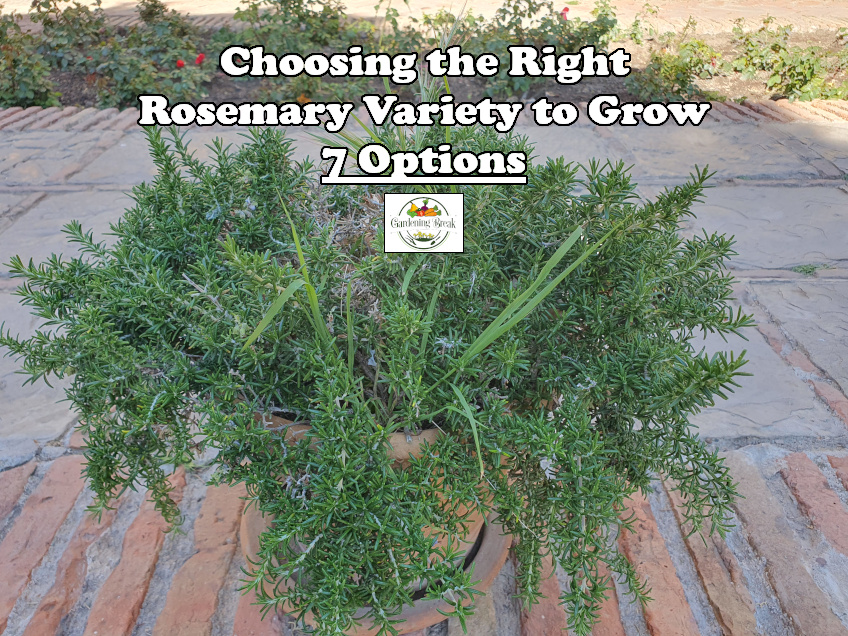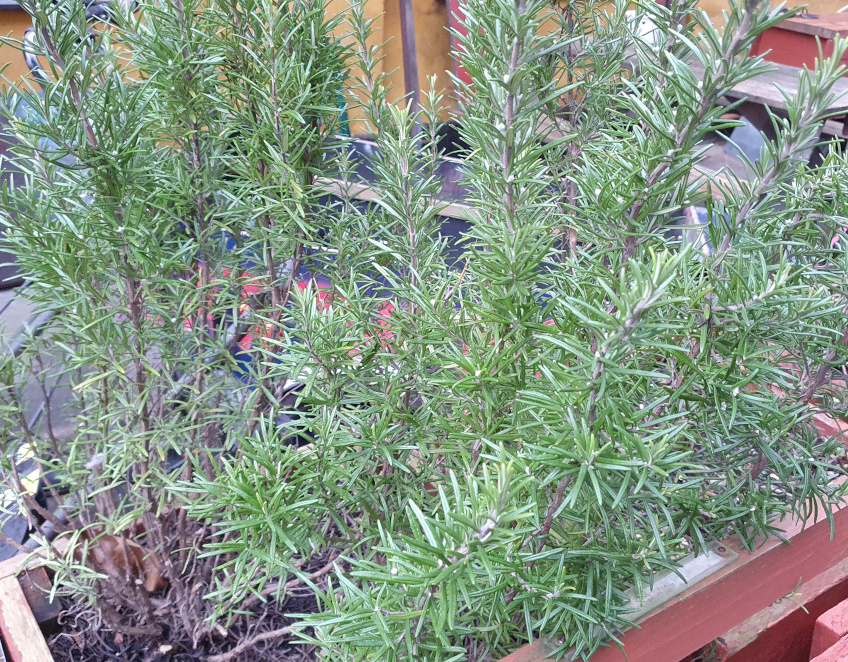
If you are planning on growing rosemary, the first decision you have to make is which variety you want to grow. There are many different varieties with different properties so picking the right one is very important. I wrote this article to help you with that.
Some rosemary varieties grow upwards and get very tall and others grow sideways or downwards in a creeping or trailing fashion. In addition to that, some varieties are better suited for certain climates than others.
In this article, I share seven of my favorite rosemary varieties and my recommendations for when each of them is good to grow so that you can pick the right one for your specific situation.
The first three varieties I cover are upright-growing and the last 4 are creeping, so if you already have a preference, you can scroll to that part of the article.
Before we dive into the list, it is essential to know which factors you should consider when choosing a variety, so I will explain that now.
Factors to Consider When Choosing a Rosemary Variety
Picking the wrong variety when growing rosemary (or any other plant) can mean that it will grow and produce at a much slower rate than otherwise or even that it might not grow at all.
The most important factors when choosing a plant variety to grow are climate, growing conditions, maintenance requirements, growth habits, and personal preferences. Different varieties can have different flavors, fragrances, and other properties, so keep that in mind when choosing.
I will get into growth habits, climate, and maintenance requirements in this article and you can read everything you need to know about growing conditions on this link.
In my opinion, the most important thing when choosing which plant or variety to grow is your personal preference. If you don’t actually want to use it or find it aesthetically pleasing then why grow it?
Let’s get into my list of 7 different rosemary varieties you should consider growing.
Tuscan Blue – (Rosmarinus Officinalis ‘Tuscan Blue’)

Tuscan Blue is a very popular upright-growing rosemary variety. It is easy to grow as long as it isn’t exposed to frost, so if you live in an area with cold winters, I recommend growing it in a pot so you can take it inside when the temperatures get too cold. Otherwise, go to this article where I share more information about what to do with rosemary at the end of the season.
Tuscan Blue doesn’t require much maintenance once it becomes well-established in its soil, so it is easy to grow and can produce a high yield of the tasty herb for you.
The only real maintenance this variety requires in my experience is that you prune it once in a while. If you know what to do, it is practically the same as harvesting, though, so it is easy. I have a full guide on how to do it on this link but here is the short version.
The easiest way to prune your rosemary is to cut long stems back by about a third with some sharp pruning shears. I use these from Amazon and I am very pleased with how good they are.
Arp – (Rosmarinus Officinalis ‘Arp’)
If you live in a colder area, Arp is one of the best rosemary varieties you can grow. It is one of the hardiest varieties that can survive lower temperatures than most others. It can even survive light frost.
That said, it will not survive being exposed to heavy frost for an extended period of time, so I recommend growing it in a pot so you can take it inside if it gets too cold.
Arp is a tall, upright-growing rosemary variety that can get up to about 3 feet (about 91cm) tall.
Hill Hardy – (Rosmarinus Officinalis ‘Hill Hardy’)
The Hill Hardy rosemary variety is the last upright-growing variety I cover in this article.
It can get slightly over 3 feet (a little over a meter) tall and wide and is, like the Arp variety I described above, a relatively cold-tolerant variety. So if you live in a relatively cold area, Hill Hardy is a good option for you.
To be honest, I don’t personally feel that much of a difference between different rosemary varieties when it comes to flavor and fragrance. The color of the flowers varies a bit between light blue and violet or purple.
One place where some rosemary varieties vary greatly, however, is in their growth habit. The 3 varieties I covered above all grow upright but now I will get into some creeping varieties that grow sideways or downwards.
Prostratus – (Rosmarinus Officinalis ‘Prostratus’)

The Prostratus rosemary variety has a very different growth habit than the varieties I’ve covered so far in this article. That’s because Rosmarinus Officinalis ‘Prostratus’ is a creeping variety, which means that it grows downwards if possible and otherwise sideways.
This variety is excellent as a ground cover since it grows out sideways. I’ve seen this in many places in the Mediterranean region, which is where rosemary originates. I took the photo above in southern Spain where I saw creeping rosemary plants like in the photo all over the place.
I personally like creeping rosemary varieties a lot since they grow in such a special way. If you grow them in pots, they will eventually almost grow all the way around the pot, hiding it, which I think is fun.
Prostratus isn’t the only creeping rosemary variety, though. I cover three more now.
Huntington Carpet – (Rosmarinus Officinalis ‘Huntington Carpet’)
Huntington Carpet is another creeping, or trailing rosemary variety.
I have seen it growing on the side of stone fences and walls many times, which I think looks great since it will grow downwards and cover more and more of the wall, almost like a carpet.
If you have a stone fence or a wall and you want some green foliage to cover some of it, plant a couple of Huntington Carpet rosemary plants about 2 feet apart at the top of the wall. Once they start growing in the summer, it won’t be long until you have a nice, dark-green carpet-like cover on your fence or wall.
Blue Rain – (Rosmarinus Officinalis ‘Blue Rain’)

The Blue Rain rosemary variety is another trailing or creeping variety that produces beautiful pale blue flowers. It grows to a bit over a foot (or about 40 cm) in height and can spread about 3 feet (about 90 cm).
Blue Rain is an excellent choice for situations where you want an ornamental and aesthetically pleasing plant that also happens to taste excellent.
One thing I love about creeping rosemary varieties, which I also recommended earlier in this article, is to grow them in a large pot. When you do that, they will eventually end up looking like the plant in my photo above, where the entire pot is almost hidden by the plant.
Golden Rain – (Rosmarinus Officinalis ‘Golden Rain’)
The Golden Rain rosemary variety is very similar to the Blue Rain variety, which I covered above, in its growth habit. It is a creeping variety that grows sideways or downwards when allowed to.
Rosmarinus Officinalis ‘Golden Rain’ gets its name because its fresh, new foliage is bright yellow rather than dark green, although it does turn dark green as it gets older. The yellow color is especially visible during spring and fall.
What to Do Once You Have Selected a Rosemary Variety to Grow
Once you have decided which rosemary variety you want to grow, the next step is to actually grow it.
You have two options.
You can grow your rosemary from seed. It can take several months for the plant to get to a point where you actually notice the growth but I find it so rewarding to see plants I grew from seed. If this is what you want, head over to the guide on this link where I explain the best way to sow rosemary seeds.
Since it takes a long time to grow rosemary from seed, many people choose to buy small plants to get a head start. This is a great option if you want to save some time but you will almost always have to transplant the small plant into a larger pot or into the ground. I have a guide for that on this link.
